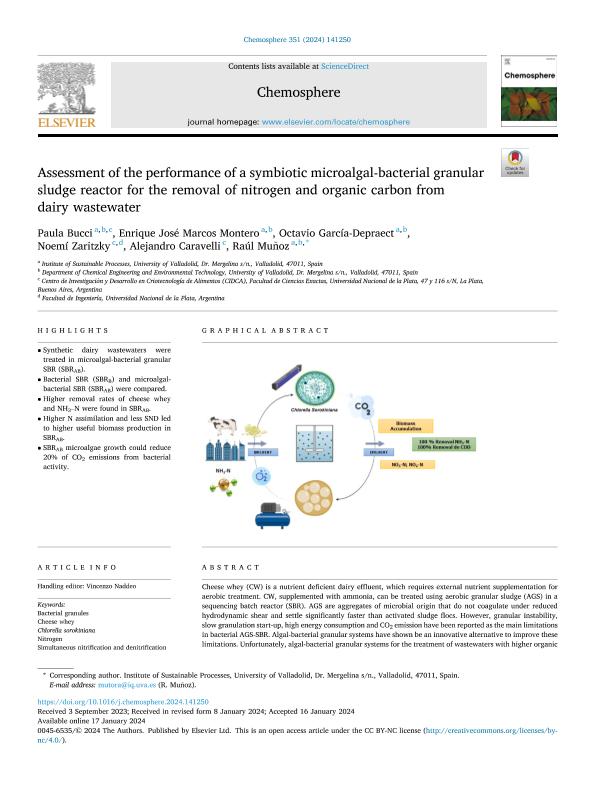Mostrar el registro sencillo del ítem
dc.contributor.author
Bucci, Paula Lorena

dc.contributor.author
Montero, Enrique José Marcos
dc.contributor.author
García Depraect, Octavio
dc.contributor.author
Zaritzky, Noemi Elisabet

dc.contributor.author
Caravelli, Alejandro Horacio

dc.contributor.author
Muñoz, Raúl
dc.date.available
2024-04-09T11:22:34Z
dc.date.issued
2024-01
dc.identifier.citation
Bucci, Paula Lorena; Montero, Enrique José Marcos; García Depraect, Octavio; Zaritzky, Noemi Elisabet; Caravelli, Alejandro Horacio; et al.; Assessment of the performance of a symbiotic microalgal-bacterial granular sludge reactor for the removal of nitrogen and organic carbon from dairy wastewater; Pergamon-Elsevier Science Ltd; Chemosphere; 351; 1-2024; 1-9
dc.identifier.issn
0045-6535
dc.identifier.uri
http://hdl.handle.net/11336/232457
dc.description.abstract
Cheese whey (CW) is a nutrient deficient dairy effluent, which requires external nutrient supplementation for aerobic treatment. CW, supplemented with ammonia, can be treated using aerobic granular sludge (AGS) in a sequencing batch reactor (SBR). AGS are aggregates of microbial origin that do not coagulate under reduced hydrodynamic shear and settle significantly faster than activated sludge flocs. However, granular instability, slow granulation start-up, high energy consumption and CO2 emission have been reported as the main limitations in bacterial AGS-SBR. Algal-bacterial granular systems have shown be an innovative alternative to improve these limitations. Unfortunately, algal-bacterial granular systems for the treatment of wastewaters with higher organic loads such as CW have been poorly studied. In this study, an algal-bacterial granular system implemented in a SBR (SBRAB) for the aerobic treatment of ammonia-supplemented CW wastewaters was investigated and compared with a bacterial granular reactor (SBRB). Mass balances were used to estimate carbon and nitrogen (N) assimilation, nitrification and denitrification in both set-ups. SBRB exhibited COD and ammonia removal of 100% and 94% respectively, high nitrification (89%) and simultaneous nitrification-denitrification (SND) of 23% leading to an inorganic N removal of 30%. The efficient algal–bacterial symbiosis in granular systems completelyremoved COD and ammonia (100%) present in the dairy wastewater. SBRAB microalgae growth could reduceabout 20% of the CO2 emissions produced by bacterial oxidation of organic compounds according to estimatesbased on synthesis reactions of bacterial and algal biomass, in which the amount of assimilated N determined bymass balance was taken into account. A lower nitrification (75%) and minor loss of N by denitrifying activity(<5% Ng, SND 2%) was also encountered in SBRAB as a result of its higher biomass production, which could beused for the generation of value-added products such as biofertilizers and biostimulants.
dc.format
application/pdf
dc.language.iso
eng
dc.publisher
Pergamon-Elsevier Science Ltd

dc.rights
info:eu-repo/semantics/openAccess
dc.rights.uri
https://creativecommons.org/licenses/by-nc/2.5/ar/
dc.subject
BACTERIAL GRANULES
dc.subject
CHEESE WHEY
dc.subject
Chlorella sorokiniana
dc.subject
NITROGEN
dc.subject
SIMULTANEOUS NITRIFICATION AND DENITRIFICATION
dc.subject.classification
Biotecnología Medioambiental

dc.subject.classification
Biotecnología del Medio Ambiente

dc.subject.classification
INGENIERÍAS Y TECNOLOGÍAS

dc.title
Assessment of the performance of a symbiotic microalgal-bacterial granular sludge reactor for the removal of nitrogen and organic carbon from dairy wastewater
dc.type
info:eu-repo/semantics/article
dc.type
info:ar-repo/semantics/artículo
dc.type
info:eu-repo/semantics/publishedVersion
dc.date.updated
2024-04-04T13:05:51Z
dc.journal.volume
351
dc.journal.pagination
1-9
dc.journal.pais
Reino Unido

dc.description.fil
Fil: Bucci, Paula Lorena. Provincia de Buenos Aires. Gobernación. Comisión de Investigaciones Científicas. Centro de Investigación y Desarrollo en Criotecnología de Alimentos. Consejo Nacional de Investigaciones Científicas y Técnicas. Centro Científico Tecnológico Conicet - La Plata. Centro de Investigación y Desarrollo en Criotecnología de Alimentos. Universidad Nacional de La Plata. Facultad de Ciencias Exactas. Centro de Investigación y Desarrollo en Criotecnología de Alimentos; Argentina
dc.description.fil
Fil: Montero, Enrique José Marcos. Universidad de Valladolid. Instituto de Procesos Sostenibles.; España
dc.description.fil
Fil: García Depraect, Octavio. Universidad de Valladolid. Instituto de Procesos Sostenibles.; España
dc.description.fil
Fil: Zaritzky, Noemi Elisabet. Provincia de Buenos Aires. Gobernación. Comisión de Investigaciones Científicas. Centro de Investigación y Desarrollo en Criotecnología de Alimentos. Consejo Nacional de Investigaciones Científicas y Técnicas. Centro Científico Tecnológico Conicet - La Plata. Centro de Investigación y Desarrollo en Criotecnología de Alimentos. Universidad Nacional de La Plata. Facultad de Ciencias Exactas. Centro de Investigación y Desarrollo en Criotecnología de Alimentos; Argentina
dc.description.fil
Fil: Caravelli, Alejandro Horacio. Provincia de Buenos Aires. Gobernación. Comisión de Investigaciones Científicas. Centro de Investigación y Desarrollo en Criotecnología de Alimentos. Consejo Nacional de Investigaciones Científicas y Técnicas. Centro Científico Tecnológico Conicet - La Plata. Centro de Investigación y Desarrollo en Criotecnología de Alimentos. Universidad Nacional de La Plata. Facultad de Ciencias Exactas. Centro de Investigación y Desarrollo en Criotecnología de Alimentos; Argentina
dc.description.fil
Fil: Muñoz, Raúl. Universidad de Valladolid. Instituto de Procesos Sostenibles.; España
dc.journal.title
Chemosphere

dc.relation.alternativeid
info:eu-repo/semantics/altIdentifier/url/https://www.sciencedirect.com/science/article/pii/S0045653524001437
dc.relation.alternativeid
info:eu-repo/semantics/altIdentifier/doi/http://dx.doi.org/10.1016/j.chemosphere.2024.141250
Archivos asociados
